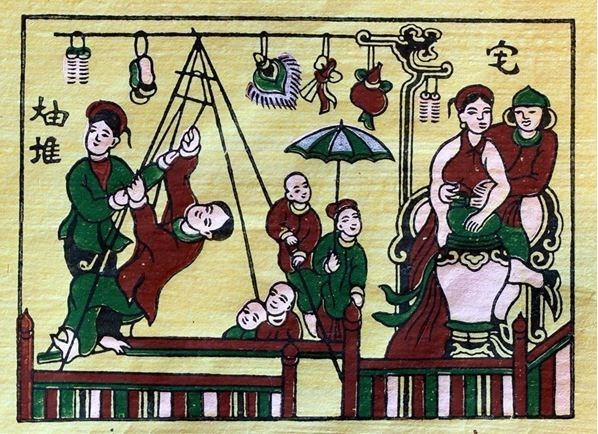


A Dong Ho folk painting (Photo
courtesy by the National Cultural Heritage Council)
Che’s decision was considered brave
by local people as at that time Dong Ho painting had to give room to modern
paintings in more and more Vietnamese homes. Che, 82, now runs an enterprise
making Dong Ho paintings and earns a stable profit.
"There are many ways to make Dong Ho painting become popular products in the
market,” said Che. "We make notebooks and postcards out of the Dong Ho painting
material. These products are souvenirs for students on birthday or special
occasions.”
Che’s family is one among the two families that still maintain the traditional craft while most villagers in Dong Ho village, Thuan Thanh district of the northern province of Bac Ninh, the home of Dong Ho folk painting now make votive paper.
Dong Ho paintings used to be essential decorations in Vietnamese houses during
the traditional Lunar New Year festival. The paintings are not just decorative,
they convey lessons about morality. However, after 500 years of existence, the
making of the painting is now on the brink of oblivion because of low demand.
In an effort to save Dong Ho painting
from oblivion, Bac Ninh province is seeking UNESCO recognition of the genre as
intangible cultural heritage in need of urgent protection.
The proposal of the People’s
Committee of Bac Ninh province to compile the dossier to gain UNESCO recognition
as an intangible cultural heritage in need of urgent safeguarding has been
ratified by the Ministry of Culture, Sports, and Tourism.
The provincial Department of Culture, Sports and Tourism has been tasked to
collaborate with related organisations to finish the dossier before it is
submitted to the provincial People’s Committee for approval.
According to Nguyen Thu Hien, deputy head of the Institute of Cultural Studies, with concrete strategies and action plans, Bac Ninh province can encourage more people to make Dong Ho paintings and help them sell their products.
The effort to secure UNESCO recognition is expected to have a significant
impact on the preservation and promotion of Vietnamese traditional values as
well as on improving communities’ awareness about the protection of such
values.
"Over the past 20 years, making Dong Ho painting is my family’s key livelihood.
But for us, Dong Ho painting means much more than a livelihood. It holds other
greater values,” said Nguyen Huu Qua, another local artisan who dedicated
to the craft.
Dong Ho’s dossier is expected to be submitted to UNESCO by 2020. Following the success of preserving Xoan folk singing, there is hope that Dong Ho painting will be revitalised./.
Source: VNA